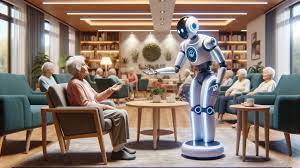The Rise of Smart Home Robots
In the era of smart technology, home automation has taken a significant leap forward with the introduction of smart home robots. These innovative devices are designed to assist users with various daily tasks, ranging from household chores to personal assistance, enhancing convenience, efficiency, and comfort in the modern home.
The Evolution of Smart Home Robots
1. Robotic Vacuum Cleaners
- Robotic vacuum cleaners, such as Roomba and Neato, autonomously navigate through homes, sweeping and vacuuming floors to keep them clean and dust-free. Equipped with advanced sensors and mapping technology, these robots can efficiently navigate around obstacles and furniture, making floor cleaning effortless for homeowners.
2. Personal Assistants
- Smart home robots like Amazon Echo and Google Home serve as personal assistants, helping users manage their schedules, set reminders, and control other connected devices with simple voice commands. These devices leverage artificial intelligence (AI) and natural language processing to understand and respond to users’ queries and requests accurately.
3. Security Robots
- Security robots, such as the Ring Always Home Cam and Arlo Security Robot, patrol homes and provide real-time monitoring of indoor and outdoor spaces. Equipped with cameras, motion sensors, and alarms, these robots can detect suspicious activity and send alerts to homeowners, enhancing home security and peace of mind.
Benefits of Smart Home Robots
1. Time-Saving Convenience
- Smart home robots automate repetitive tasks, such as vacuuming, mopping, and scheduling, freeing up valuable time for users to focus on other priorities or leisure activities. By streamlining household chores, these robots simplify daily routines and improve overall productivity.
2. Enhanced Accessibility
- Smart home robots offer assistance to users with mobility or accessibility challenges, enabling them to perform tasks independently and maintain a sense of autonomy and dignity. Whether it’s controlling devices through voice commands or accessing information hands-free, these robots promote inclusivity and empowerment for all users.
3. Improved Efficiency
- With advanced sensors and AI algorithms, smart home robots can optimize their performance based on user preferences and environmental conditions. Whether it’s adjusting cleaning patterns, optimizing energy usage, or learning user habits over time, these robots adapt to their surroundings to deliver optimal results with minimal intervention.
Challenges and Considerations
1. Cost
- The upfront cost of smart home robots can be a barrier for some consumers, particularly those on a tight budget or uncertain about the long-term benefits. However, as technology advances and adoption rates increase, prices are expected to become more affordable over time.
2. Privacy Concerns
- Smart home robots collect data about users’ habits, preferences, and activities to improve their functionality and performance. While this data can enhance the user experience, it also raises concerns about privacy and data security. It’s essential for manufacturers to prioritize user privacy and implement robust security measures to protect sensitive information.
Embracing the Future of Home Automation
As smart home technology continues to evolve, smart home robots are poised to play a central role in shaping the future of home automation. By providing users with personalized assistance, enhancing convenience, and improving efficiency, these robots are revolutionizing the way we live and interact with our living spaces.




